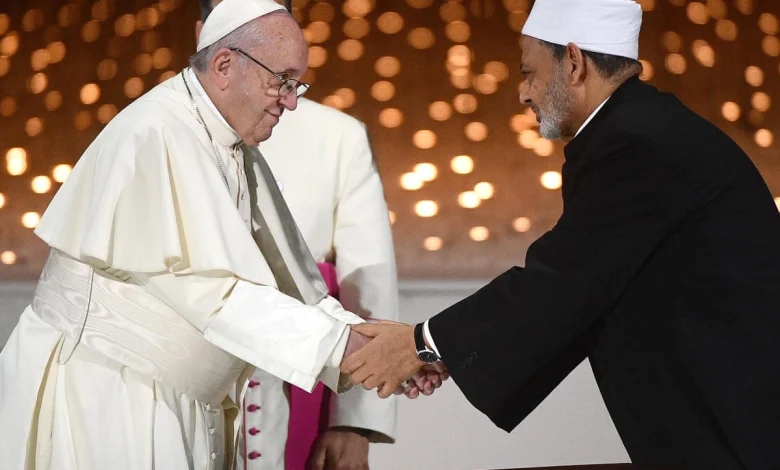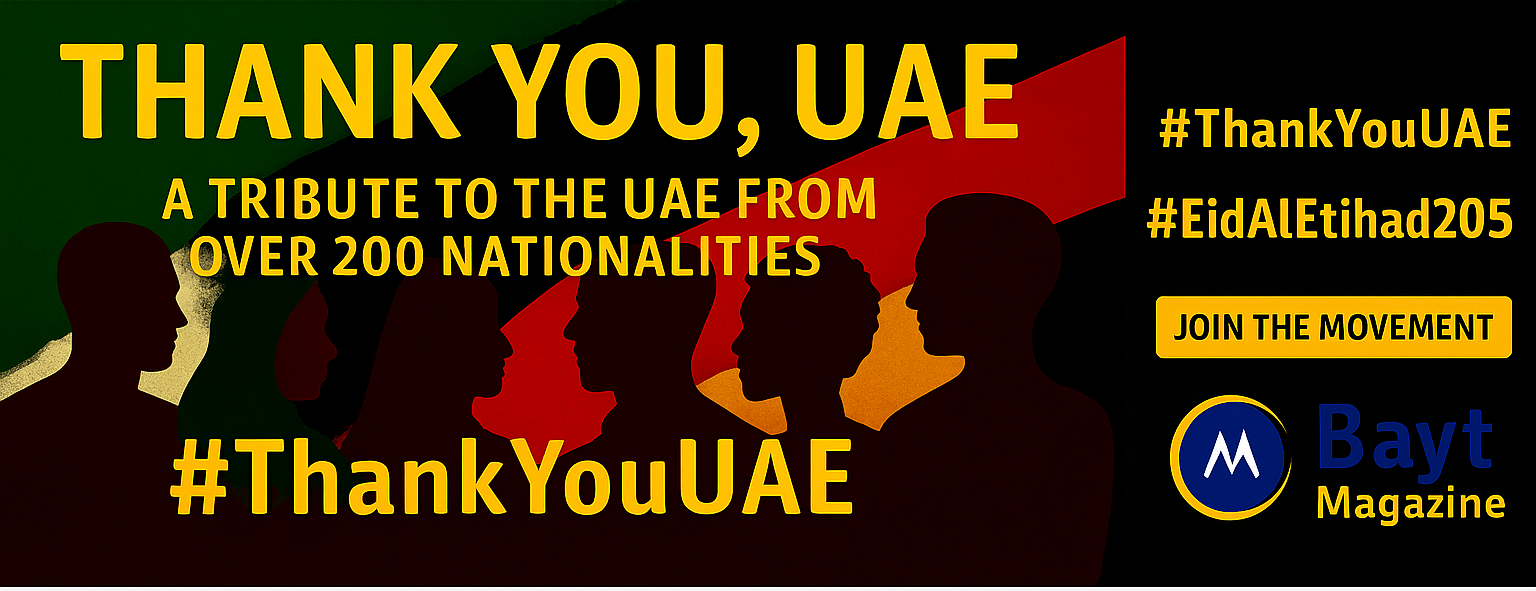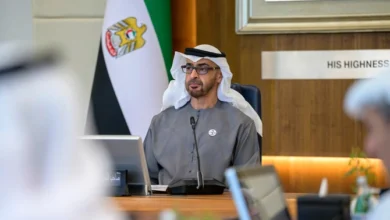
Exploring the Vision of the Document on Human Fraternity
Pope Francis and the Grand Imam of Al-Azhar Ahmad al-Tayyeb made history by signing the Document on Human Fraternity on February 4, 2019, in Abu Dhabi. The world watched as these two religious leaders joined forces to champion peace and mutual understanding.
The document guides future generations to build a culture of mutual respect. Its principles of human fraternity and harmonious coexistence are the foundations of this joint statement, which has sparked many meetings and discussions worldwide. The United Nations recognized the text’s importance and declared February 4 as the International Day of Human Fraternity.
This piece delves into the Document on Human Fraternity’s vision. We’ll learn about its origins, core values, religious pluralism approach, anti-violence stance, and strategies for implementation. The declaration’s ongoing impact on global dialog remains strong, as shown by the International Forum on Human Fraternity that brought together nearly 1,900 international officials, experts, and academics from across the globe.
The Origins and Purpose of the Document on Human Fraternity
Image Source: The Guardian
Two religious leaders met in early 2019, marking a turning point in interfaith dialog. Relations between the Vatican and Al-Azhar had seen tense periods, which made this reunion one of the most important events in recent history.
The Abu Dhabi meeting and its significance
Pope Francis and Grand Imam Ahmad al-Tayyeb made history on February 4, 2019. They met at the Founder’s Memorial in Abu Dhabi to sign the Document on Human Fraternity for World Peace and Living Together. This event broke new ground as the first papal visit to Islam’s birthplace, the Arabian Peninsula. The timing carried special meaning too, as it marked 800 years since St. Francis met Sultan al-Kamil in Damietta, Egypt.
The Pope’s UAE visit (February 3-5, 2019) featured two embraces and two signatures that sealed a path of meetings in the “spirit of Assisi”. The meeting fulfilled John Paul II’s dream where religions pray for peace and each other, not against one another.
Pope Francis and Grand Imam Al-Tayyeb’s shared vision
These religious leaders built their relationship through several meetings. Their encounters helped heal the broken ties between the Vatican and Al-Azhar. They developed a strong bond based on mutual respect and understanding.
Both leaders worked to curb extremism and terrorism while promoting peace. Their meetings in Rome and Cairo focused on ways to address violence and terrorism. What started as a cold relationship transformed into solidarity, bringing Catholic and Muslim leaders together.
Pope Francis and Grand Imam Al-Tayyeb see Islam and Christianity as faiths that share strong theological and ethical foundations. These foundations are the basis for dialog, solidarity, and service to humanity.
Why the document was created
“Fraternal and open discussions” led to the Document on Human Fraternity, expressing “profound hope in a bright future for all human beings”. The document responds to today’s global challenges: religious extremism, violence, and worldwide moral and cultural decline.
This document serves as an ethical guide and theological framework that supports shared values between faiths. It asks “all persons who have faith in God and faith in human fraternity to unite and work together” to “serve as a guide for future generations to advance a culture of mutual respect”.
The declaration points to the common causes of modern world crises – dulled human conscience, drift from religious values, and widespread individualism with materialistic philosophies. World leaders and international policy makers must “work strenuously to spread the culture of tolerance and of living together in peace”.
This blueprint guides dialog and collaboration between faiths, showing we belong to one human family.
Core Values Promoted in the Document
The Document on Human Fraternity contains fundamental values that surpass religious boundaries. Its declaration opens with powerful invocations that establish an ethical framework and highlight shared moral ground between Christianity and Islam.
Peace and mutual respect
Peace and mutual respect serve as the life-blood of human coexistence in this document. A sacred invocation begins: “In the name of God who has created all human beings equal in rights, duties and dignity, and who has called them to live together as brothers and sisters, to fill the earth and make known the values of goodness, love and peace”. These words set the foundation for meaningful interfaith dialog.
The document describes faith as a path that guides believers to see others as family members who deserve support and love. This viewpoint transforms how believers see people of different faiths—not as outsiders but as part of one human family. Believers must “express this human fraternity by safeguarding creation and the entire universe and supporting all persons, especially the poorest and those most in need”.
Justice and mercy as foundations
Justice and mercy emerge repeatedly as vital pillars throughout the text. The document specifically names them as “the foundations of prosperity and the life-blood of faith”. This intentional pairing balances justice and mercy—one without the other falls short.
The text clearly states that “mercy-based justice is the path to be followed in order to achieve a dignified life to which every human being has the right”. This approach protects rights while keeping human compassion central.
Good deeds must follow philosophical agreement. The declaration notes that without action “for everyone in need, the poor, the destitute and the sick, [human fraternity] remains a resonant and lofty slogan, but it is truncated and useless”.
Human dignity and equality
Human dignity and equality receive the strongest emphasis. The document states clearly that all human beings are “equal in rights, duties and dignity”. This equality forms the foundation for citizenship concepts presented in the text.
Citizenship “is based on the equality of rights and duties, under which all enjoy justice”. The text rejects using the term “minorities” as it can “engender feelings of isolation and inferiority”. Instead, it promotes “full citizenship” where everyone has equal standing whatever their faith tradition.
Our humanity distinguishes us from other creatures, and the document affirms that “the more human we are, the more we feel the needs and sufferings of others”. This empathetic aspect of human dignity creates responsibility toward others.
Living together in Abu Dhabi: a symbolic gesture
Abu Dhabi represents a living example of the document’s principles. The UAE has allowed unmarried couples to live together legally since 2020, “marking a major shift from its conservative past”. This change brings the document’s values into everyday life.
Many expats find living together in Abu Dhabi convenient and flexible. Couples maintain discretion and respect cultural norms. This balanced approach shows how tradition and progress work together.
Recent legal reforms reflect a move toward inclusion while preserving cultural identity. The UAE government has created more relaxed laws for unmarried couples. These changes recognize Abu Dhabi’s diverse international community and put the document’s vision into practice—creating spaces where different backgrounds coexist respectfully.
Religious Pluralism and Freedom of Belief
The Document on Human Fraternity stands out with its bold take on religious diversity. It shows us a way to acknowledge our differences yet emphasizes our shared humanity. This fresh view helps us understand how different faiths can thrive together in today’s world.
Understanding pluralism as divine will
The document makes a powerful statement: “The pluralism and the diversity of religions, color, sex, race and language are willed by God in His wisdom, through which He created human beings”. This deep insight places religious diversity within God’s wisdom rather than seeing it as something we need to fix.
God’s design covers diversity itself. Religious expressions appear as part of a sacred order, and the Qur’an tells us “if God had willed, He would have made one community; but he did not”. This theological framework shows plurality isn’t just tolerated – it serves a purpose with “God Himself as the final goal”.
Freedom of religion and expression
Religious freedom and human rights are the foundations of this document’s message. “Freedom is a right of every person: each individual enjoys the freedom of belief, thought, expression and action”.
The text links religious freedom with human dignity. These two concepts “inseparably linked” show us that true religious freedom goes beyond worship. People should be able to live “in accordance with religious convictions”.
The document takes a clear stance against religious coercion: “The fact that people are forced to adhere to certain religion or culture must be rejected, as too the imposition of a cultural way of life that others do not accept”. This applies equally to majority and minority religious groups.
Theological debates and clarifications
The statement about God willing religious diversity sparked intense theological debates. Catholic theologians questioned its alignment with traditional salvation doctrine.
Chad Pecknold from Catholic University of America saw the statement as “fitting in sensitive inter-religious contexts.” He explained that Pope Francis referred “not to the evil of many false religions, but positively… to the diversity of religions” as proof of “our natural desire to know God”.
Bishop Athanasius Schneider shared that Pope Francis explained he meant “the permissive will of God”. All the same, other theologians suggested different interpretations that keep both theological integrity and interfaith respect intact.
The document wants to create an “ethics of pluralism” instead of getting stuck in theological arguments. It asks believers to focus on “spiritual, human, and shared social values” and avoid “unproductive discussions” that might distract from working together.
Condemnation of Violence and Misuse of Religion
Image Source: Catholic News Agency
The Document on Human Fraternity stands firmly against violence committed in religion’s name. This significant declaration challenges faith traditions’ misuse that has driven conflicts throughout history.
Rejecting extremism and terrorism
The document clearly denounces “all those practices that are a threat to life such as genocide, acts of terrorism, forced displacement, human organ trafficking, abortion and euthanasia”. Terrorism “threatens the security of people, be they in the East or the West, the North or the South, and distributes panic, terror and pessimism”.
Misinterpretation of religious texts
The document states that terrorism “is not due to religion, even when terrorists instrumentalize it” after looking at why it happens. These tragic events emerge from “an accumulation of incorrect interpretations of religious texts and to policies linked to hunger, poverty, injustice, oppression and pride”.
Call to stop using religion for political gain
The document’s signatories “call upon all concerned to stop using religions to incite hatred, violence, extremism and blind fanaticism, and to refrain from using the name of God to justify acts of murder, exile, terrorism and oppression”. Such actions represent “the consequence of a deviation from religious teachings” that stems from “political manipulation of religions”.
Implementing the Vision: Education and Policy
Image Source: President José Ramos-Horta
The Document on Human Fraternity needs concrete action through educational systems and policy frameworks to become reality. The document shows several ways to make this happen.
Role of schools and universities
Al-Azhar and the Catholic Church want “this Document become the object of research and reflection in all schools, universities and institutes of formation”. Their main goal focuses on teaching new generations to “bring goodness and peace to others, and to be defenders everywhere of the rights of the oppressed”. Educational institutions play a vital role as they shape these human fraternity values.
The Higher Committee on Human Fraternity
The Higher Committee of Human Fraternity started its journey on August 15, 2019, right after the document’s signing. This independent international committee works to spread human fraternity values worldwide. Their mission aims to realize “the aspirations of the Abu Dhabi Document on Human Fraternity”. Religious leaders from both faiths make up the committee and provide a global platform that advances cooperation.
UN recognition and International Day of Human Fraternity
The United Nations General Assembly made a significant decision in December 2020. They declared February 4 as the International Day of Human Fraternity. World leaders supported this annual celebration that first took place in 2021.
Translating values into laws and curricula
The document emphasizes turning these principles into real-world changes through “translating principles into policies, decisions, legislative texts, courses of study and materials”. Schools should teach “values of tolerance and pluralism” by adding human fraternity concepts to their curriculum.
The Document on Human Fraternity marks a milestone in interfaith relations. Religious differences sparked conflicts throughout history. This declaration brings a radical change to that pattern. Pope Francis and Grand Imam Ahmad al-Tayyeb showed remarkable leadership. They built common ground between Christianity and Islam and created a framework where faiths can coexist peacefully instead of competing.
The core principles of human dignity, equality, justice, and mercy surpass religious boundaries. The document embraces religious pluralism while standing against extremism that weaponizes faith for violence or political advantage. Its impact reaches beyond religious circles and influences international relations, education systems, and legal frameworks worldwide.
The document’s practical implementation strategies need our attention. Schools and universities now have the task to nurture human fraternity values in young minds. On top of that, the Higher Committee on Human Fraternity works hard to turn these principles into real actions in communities of all types.
The document stays focused on practical cooperation rather than unproductive debates, even when faced with theological questions. This hands-on approach lets people of different faiths cooperate on shared humanitarian goals while keeping their unique religious identities intact.
The United Nations’ decision to mark February 4 as the International Day of Human Fraternity shows this initiative’s worldwide importance. Words alone can’t change societies, but they definitely point the way forward. The document provides both vision and concrete steps toward a world where diversity makes us stronger, not divided.
Human fraternity is more than just an ideal—it shows our dedication to embrace our shared humanity across religious, cultural, and social differences. We need ongoing dialog, education, and policy changes to move forward. The Document on Human Fraternity has planted seeds of peace that will help generations to come.




